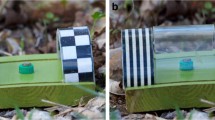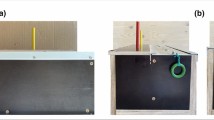Abstract
Keas, a species of parrots from New Zealand, are an interesting species for comparative studies of problem solving and cognition because they are known not only for efficient capacities for object manipulation but also for explorative and playful behaviors. To what extent are they efficient or explorative, and what cognitive abilities do they use? We examined how keas would solve several versions of artificial-fruit box problems having multiple locks. After training keas to remove a metal rod from over a Plexiglas lid that had to be opened, we exposed the birds to a variety of tasks having two or more locks. We also introduced a preview phase during which the keas had extended opportunity to look at the tasks before the experimenter allowed the birds to solve them, to examine whether the preview phase would facilitate the birds’ performance on the tasks. In a large number of tests, the keas showed a strong trend to solve the tasks with no positive effect of previewing the tasks. When the tasks became complex, however, the keas corrected inappropriate responses more quickly when they had had chance to preview the problems than when they had not. The results suggest that the keas primarily used explorative strategies in solving the lock problems but might have obtained some information about the tasks before starting to solve them. This may reflect a good compromise of keas’ trial-and-error tendency and their good cognitive ability that result from a selection pressure they have faced in their natural habitat.



Similar content being viewed by others
References
Adams-Curtis L, Fragaszy DM (1995) Influence of a skilled model of the behavior of conspecific observers in tufted capuchin monkeys (Cebus apella). Am J Primatol 37:65–71
Auersperg AMI, Gajdon GK, Huber L (2009) Kea (Nestor notabilis) consider spatial relationships between objects in the support problem. Biol Lett 5:455–458
Biro D, Matsuzawa T (1999) Numerical ordering in a chimpanzee (Pan troglodytes): planning, executing, and monitoring. J Comp Psychol 113:178–185
Brejaart R (1988) Diet and feeding behaviour of the kea (Nestor notabilis). Dissertation, Lincoln University
Chappell J, Kacelnik A (2002) Tool selectivity in a non-primate, the New Caledonian crow (Corvus moneduloides). Anim Cogn 5:1–17
Chittka L, Niven J (2009) Are bigger brains better? Curr Biol 19:R995–R1008
Clark CMH (1970) Observations on population, movements and food of the kea (Nestor notabilis). Notornis 17:105–114
Correia SPC, Dickinson A, Clayton NS (2007) Western scrub-jays (Aphelocoma Californica) anticipate future needs independently of their current motivational state. Curr Biol 17:856–861
Diamond J, Bond AB (1999) Kea, bird of paradox. The evolution and behavior of a New Zealand parrot. University of California Press, Berkeley
Diamond J, Bond AB (2003) A comparative analysis of social play in birds. Behaviour 140:1091–1115
Diamond J, Bond AB (2004) Social Play in Kaka (Nestor meridionalis) with comparisons to Kea (Nestor notabilis). Behaviour 141:777–798
Dunbar RIM, McAdam MR, O’Connell S (2005) Mental rehearsal in great apes (Pan troglodytes and Pongo pygmaeus) and children. Behav Process 69:323–330
Emery NJ, Clayton NS (2001) Effects of experience and social context on prospective caching strategies in scrub jays. Nature 414:443–446
Emery NJ, Clayton NS (2004) Comparing the complex cognition of birds and primates. In: Rogers LJ, Kaplan GT (eds) Comparative vertebrate cognition: are primates superior to non-primates? Kluwer Academic/Plenum Publishers, New York, pp 3–55
Fragaszy D, Johnson-Pynn E, Hirsh E, Brakke K (2003) Strategic navigation of two-dimensional alley mazes: comparing capuchin monkeys and chimpanzees. Anim Cogn 6:149–160
Gajdon GK, Fijn N, Huber L (2004) Testing social learning in a wild mountain parrot, the kea (Nestor notabilis). Learn Behav 32:62–71
Gajdon GK, Fijn N, Huber L (2006) Limited spread of innovation in a wild parrot, the kea (Nestor notabilis). Anim Cogn 9:173–181
Huber L, Gajon GK (2006) Technical intelligence in animals: the kea model. Anim Cogn 9:295–305
Huber L, Rechberger S, Taborsky M (2001) Social learning affects object exploration and manipulation in keas, Nestor notabilis. Anim Behav 62:945–954
Huber L, Gajdon GK, Federspiel I, Wedernich D (2008) Cooperation in keas: social and cognitive factors. In: Itakura S, Fujita K (eds) Origins of the social mind: evolutionary and developmental views. Springer, Tokyo, pp 97–117
Iversen IH, Matsuzawa T (2003) Development of interception of moving targets by chimpanzees (Pan troglodytes) in an automated task. Anim Cogn 6:169–183
Iwaniuk AN, Dean KM, Nelson JE (2005) Interspecific allometry of the brain and brain regions in parrots (Psittaciformes): comparisons with other birds and primates. Brain Behav Evol 65:40–59
Kawai N, Matsuzawa T (2000) Numerical memory span in a chimpanzee. Nature 403:39–40
Kubat S (1992) Die Rolle von Neuigkeit, Andersartigkeit, und sozialer Struktur für Die Exploration von Objekten beim Kea (Nestor notabilis). Dissertation, University of Vienna
Miyata H, Fujita K (2008) Pigeons (Columba livia) plan future moves on computerized maze tasks. Anim Cogn 11:505–516
Miyata H, Fujita K (2010) Route selection by pigeons (Columba livia) on “traveling salesperson” navigation tasks presented on the LCD screen. J Comp Psychol (in press)
Miyata H, Ushitani T, Adachi I, Fujita K (2006) Performance of pigeons (Columba livia) on maze problems presented on the LCD screen: In search for preplanning ability in an avian species. J Comp Psychol 120:358–366
Miyata H, Itakura S, Fujita K (2009) Planning in human children (Homo sapiens) assessed by maze problems on the touch screen. J Comp Psychol 123:69–78
Mulcahy NJ, Call J (2006) Apes save tools for future use. Science 312:1038–1040
Mushiake H, Saito N, Sakamoto K, Sato Y, Tanji J (2001) Visually based path planning by Japanese monkeys. Cogn Brain Res 11:165–169
Mushiake H, Saito N, Sakamoto K, Itoyama Y, Tanji J (2006) Activity in the prefrontal cortex reflects multiple steps of future events in action plans. Neuron 50:631–641
Raby CR, Alexis DM, Dickinson A, Clayton NS (2007) Planning for the future by western scrub-jays. Nature 445:919–921
Rensch B (1973) Play and art in monkeys and apes. In: Jr Menzel EW (ed) Symposium of the 4th international congress of primatology, vol. 1: precultural primate behavior. Karger, Basel, Switzerland, pp 102–103
Ritzmeier M (1995) The influence on hunger and low predation diet on exploration in keas (Nestor notabilis). Dissertation, Konrad Lorenz Institute for Ethology, University of Vienna
Roberts WA (2002) Are animals stuck in time? Psychol Bull 128:473–489
Schloegl C, Dierks A, Gajdon GK, Huber L, Kotrschal K, Bugnyar T (2009) What you see is what you get? Exclusion performances in ravens and keas. PLoS ONE 4:e6368. doi:10.1371/journal.pone.0006368
Shima K, Isoda M, Mushiake H, Tanji J (2007) Categorization of behavioural sequences in the prefrontal cortex. Nature 445:315–318
Suddendorf T (2006) Foresight and evolution of the human mind. Science 312:1006–1007
Temple P (1996) The book of the kea. Hodder Moa Beckett, Auckland
Werdenich D, Huber L (2006) A case of quick problem solving in birds: string pulling in keas, Nestor notabilis. Anim Behav 71:855–863
Acknowledgments
This study was supported by the Research Fellowship of the Japan Society for the Promotion of Science (JSPS) for Young Scientists to Hiromitsu Miyata, the Austrian Science Fund (FWF) Grant P19087-B17 (to Ludwig Huber), the Grants-in-Aid for Scientific Research Nos. 17300085 and 20220004 from JSPS to Kazuo Fujita, and by the Japan Ministry of Education, Culture, Sport, Science, and Technology (MEXT) Global COE Program, D-07, to Kyoto University. The experiments adhered to the Austrian law of animal keeping and research. The authors declare that they have no conflict of interest.
Author information
Authors and Affiliations
Corresponding author
Rights and permissions
About this article
Cite this article
Miyata, H., Gajdon, G.K., Huber, L. et al. How do keas (Nestor notabilis) solve artificial-fruit problems with multiple locks?. Anim Cogn 14, 45–58 (2011). https://doi.org/10.1007/s10071-010-0342-9
Received:
Revised:
Accepted:
Published:
Issue Date:
DOI: https://doi.org/10.1007/s10071-010-0342-9




